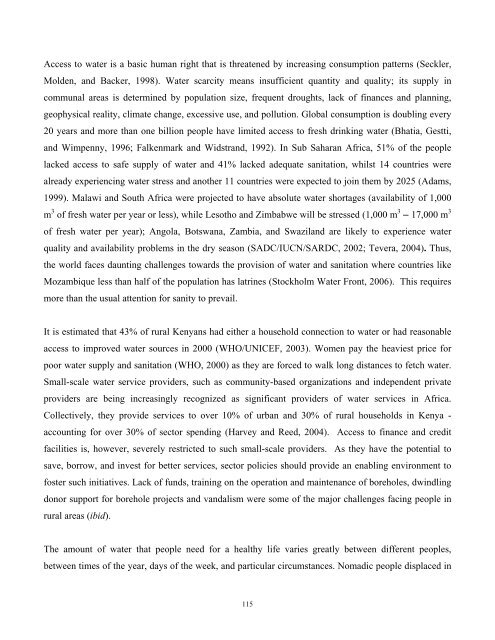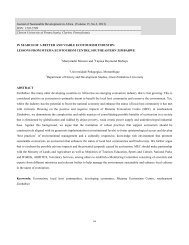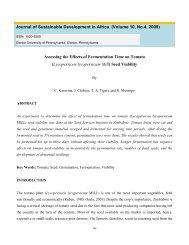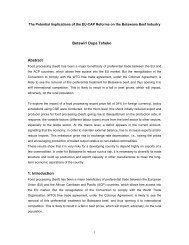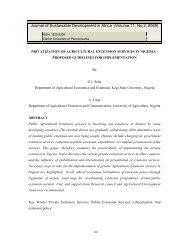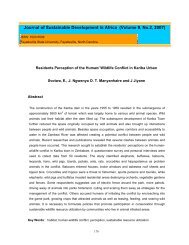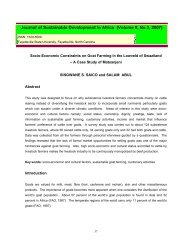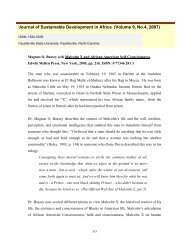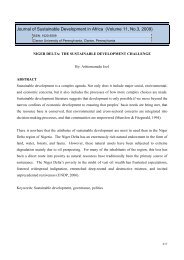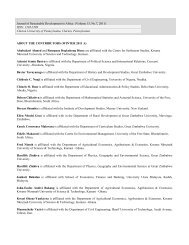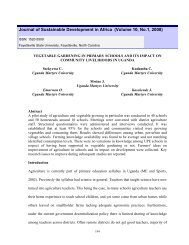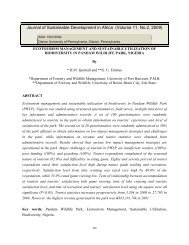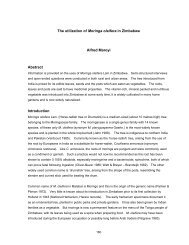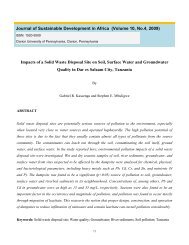Access to Safe Drinking Water by Rural Communities in Zimbabwe
Access to Safe Drinking Water by Rural Communities in Zimbabwe
Access to Safe Drinking Water by Rural Communities in Zimbabwe
You also want an ePaper? Increase the reach of your titles
YUMPU automatically turns print PDFs into web optimized ePapers that Google loves.
<strong>Access</strong> <strong>to</strong> water is a basic human right that is threatened <strong>by</strong> <strong>in</strong>creas<strong>in</strong>g consumption patterns (Seckler,<br />
Molden, and Backer, 1998). <strong>Water</strong> scarcity means <strong>in</strong>sufficient quantity and quality; its supply <strong>in</strong><br />
communal areas is determ<strong>in</strong>ed <strong>by</strong> population size, frequent droughts, lack of f<strong>in</strong>ances and plann<strong>in</strong>g,<br />
geophysical reality, climate change, excessive use, and pollution. Global consumption is doubl<strong>in</strong>g every<br />
20 years and more than one billion people have limited access <strong>to</strong> fresh dr<strong>in</strong>k<strong>in</strong>g water (Bhatia, Gestti,<br />
and Wimpenny, 1996; Falkenmark and Widstrand, 1992). In Sub Saharan Africa, 51% of the people<br />
lacked access <strong>to</strong> safe supply of water and 41% lacked adequate sanitation, whilst 14 countries were<br />
already experienc<strong>in</strong>g water stress and another 11 countries were expected <strong>to</strong> jo<strong>in</strong> them <strong>by</strong> 2025 (Adams,<br />
1999). Malawi and South Africa were projected <strong>to</strong> have absolute water shortages (availability of 1,000<br />
m 3 of fresh water per year or less), while Lesotho and <strong>Zimbabwe</strong> will be stressed (1,000 m 3 – 17,000 m 3<br />
of fresh water per year); Angola, Botswana, Zambia, and Swaziland are likely <strong>to</strong> experience water<br />
quality and availability problems <strong>in</strong> the dry season (SADC/IUCN/SARDC, 2002; Tevera, 2004). Thus,<br />
the world faces daunt<strong>in</strong>g challenges <strong>to</strong>wards the provision of water and sanitation where countries like<br />
Mozambique less than half of the population has latr<strong>in</strong>es (S<strong>to</strong>ckholm <strong>Water</strong> Front, 2006). This requires<br />
more than the usual attention for sanity <strong>to</strong> prevail.<br />
It is estimated that 43% of rural Kenyans had either a household connection <strong>to</strong> water or had reasonable<br />
access <strong>to</strong> improved water sources <strong>in</strong> 2000 (WHO/UNICEF, 2003). Women pay the heaviest price for<br />
poor water supply and sanitation (WHO, 2000) as they are forced <strong>to</strong> walk long distances <strong>to</strong> fetch water.<br />
Small-scale water service providers, such as community-based organizations and <strong>in</strong>dependent private<br />
providers are be<strong>in</strong>g <strong>in</strong>creas<strong>in</strong>gly recognized as significant providers of water services <strong>in</strong> Africa.<br />
Collectively, they provide services <strong>to</strong> over 10% of urban and 30% of rural households <strong>in</strong> Kenya -<br />
account<strong>in</strong>g for over 30% of sec<strong>to</strong>r spend<strong>in</strong>g (Harvey and Reed, 2004). <strong>Access</strong> <strong>to</strong> f<strong>in</strong>ance and credit<br />
facilities is, however, severely restricted <strong>to</strong> such small-scale providers. As they have the potential <strong>to</strong><br />
save, borrow, and <strong>in</strong>vest for better services, sec<strong>to</strong>r policies should provide an enabl<strong>in</strong>g environment <strong>to</strong><br />
foster such <strong>in</strong>itiatives. Lack of funds, tra<strong>in</strong><strong>in</strong>g on the operation and ma<strong>in</strong>tenance of boreholes, dw<strong>in</strong>dl<strong>in</strong>g<br />
donor support for borehole projects and vandalism were some of the major challenges fac<strong>in</strong>g people <strong>in</strong><br />
rural areas (ibid).<br />
The amount of water that people need for a healthy life varies greatly between different peoples,<br />
between times of the year, days of the week, and particular circumstances. Nomadic people displaced <strong>in</strong><br />
115


